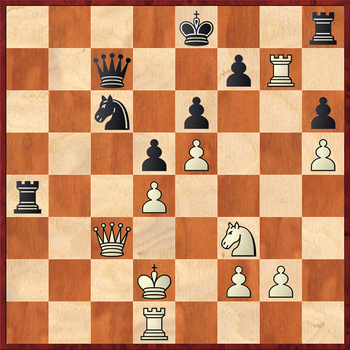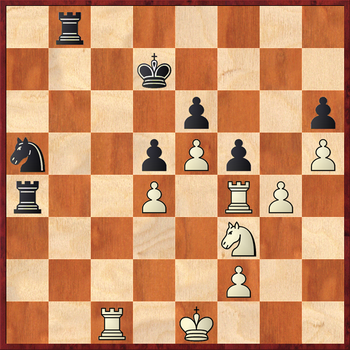Annotated by GM Alexander Kalinin
GM Yuri Eliseev maintains the lead confidently as he hasn't lost even half a point. This time he won an important game against a tournament favorite GM Vladislav Artemiev who is considered one of the most talented Russian young players.
Workdays and holidays
The audience always want to see striking games – preferably with attacks and nice sacrifices. But that's not always the case. From the 25 games the commentator observes every day, this time he failed to find an encounter able to fully satisfy the taste of chess gourmets. So, we just chose the key game of the round.
The leaders' battle wasn't full of effects but was extremely tense. After all, in chess as well as in life we can’t celebrate holidays every day…
Eliseev, Yuri– Artemiev Vladislav
Russia Cup Stage 2016
1.e4 c5 2.Nf3 a6
The main aim of this rare continuation is to avoid open Sicilian play: if 3.d4 cxd4 4.Nxd4 Nf6 5.Nc3 then 5…e5!.
3.c3
This is considered to be the main response, since the move а7-а6 doesn’t look very useful when it comes to the Alapin variation.
3...e6 4.d4 d5 5.e5
This move leads to the Nimzowitsch system in the French Defense. Once again White chooses a direction where Black's 2nd move will be of little use. If the position transposed to a structure with the isolated d5-pawn, a7-a6 would turn out very helpful.
5…Bd7
Consistently played, as the а6-pawn will help Black to prepare the exchange of his French bishop. However, in the usual French the same is fulfilled by more useful and aggressive Qd8-b6.
The question may arise: why Black chose the second-sort version of the French Defense during his preparation? The answer might be that firstly, theoretical arguments and a fight over the board are quite different things; secondly, even a good version of a position with blocked pawn-chains is not enough to encourage an opponent who loves an open game.
6.Bd3 cxd4
Immediate 6...Bb5 7.Bxb5+ axb5 8.dxc5 Bxc5 9.b4! Bb6 10.Na3 loses the b5-pawn.
7.cxd4 Bb5

8.Bc2
A typical idea. White doesn’t exchange his important light-squared bishop, thinking that the black "French" bishop will shoot into emptiness.
8...Bb4+ 9.Bd2 a5 10.a3
For better understanding of the previous moves we will mention the game Z. Azmaiparashvili – N. Rashkovsky (USSR Championship, Kiev 1986): 10.Nc3 Bxc3 (or 10...Ba6 11.Ne2 Nc6 12.0–0 Nge7 13.a3 Bxd2 14.Qxd2 Qb6 15.Rfe1 Bxe2! with satisfactory play for Black, K. Aseev – V. Eingorn, Berlin 1997) 11.Bxc3 Nc6 12.h4 Nge7 13.h5 h6 14.Rh4 Qc7 15.Rg4 Nb4 16.Bb1 Qc4 17.Nd2 Nd3+ 18.Bxd3 Qxd3 19.a4 Ba6 20.Bxa5 Rc8 21.Ra3 Qf5 with mutual chances.
10...Bxd2+ 11.Qxd2 Ne7 12.Nc3 Ba6

13.h4
The quiet alternative is 13.Bd3, trying to point out vulnerability of the b5-square.
13...h6 14.Rh3!
The rook joins the battle via the 3rd rank, creating the opportunity to attack Black's kingside.
14...Nd7 15.h5 Qc7 16.Rg3

16...Qc4
By sacrificing the g7-pawn, Black tries to organize counterplay on the opposite side of the board. Let’s note that passive defense (16...Kf8 17.Qf4) looks very dangerous for the black king.
17.0–0–0 b5 18.b3! Qc7 19.Rxg7

19...b4
Perhaps it's a premature decision. 19...Nb6! could lead to a tense and unpredictable situation.
20.axb4 axb4 21.Na4 Bb5 22.Qxb4 Bxa4 23.bxa4 Nb6?!
More precise is 23...Rb8 24.Qa3 Rc8 25.Qb3 (or 25.Ne1 Nb6 26.Qc5 Qa7 27.Qb5+ Kf8 28.Rg3 Nc4) 25...Nc6, and Black has compensation for the sacrificed pawns because he holds the white king on the queenside.

24.Kd2!
White returns one of his extra pawns but the king will be out of the danger zone.
24…Nc6 25.Qc3 Nxa4 26.Bxa4 Rxa4

White has consolidated its position and has a clear advantage due to his extra pawn.
27.Rb1 Kf8 28.Rg4 Ke7 29.Qc5+ Kd7 30.Rf4
More precise was 30.Rg7 restricting Black’s opportunities.
30...f5! 31.g4 Rb8

32.Rc1!
It’s necessary for White to keep the rook which is defending the king.
An amazing variant could arise in case of impatient rook sacrifice: 32.gxf5 Rxb1 33.fxe6+ Kc8 34.Rf8+ Kb7 35.Rf7 Ra2+ 36.Ke3 Rb3+ 37.Kf4 Rxf2 38.Rxc7+ Kxc7 39.Qd6+ Kb6 40.Qxd5 Rbxf3+ 41.Qxf3 Rxf3+ 42.Kxf3 Nxd4+ 43.Ke4 Nxe6 44.Kf5 Nf8 with a draw by total mutual extermination!
32...Qa5+ 33.Qxa5 Nxa5 34.Ke1
It would be more solid to protect the second rank - 34.Rc2.

34...Nb3?
A mistake in time-trouble. The counterchances could be kept by 34...fxg4 35.Rxg4 Rb2!. Now it's over.
35.Rb1 fxg4 36.Rxg4 Rab4 37.Rg7+ Kc8 38.Rh7 R8b6 39.Rd1 Rc6 40.Rxh6 Kd7 41.Rh7+ Ke8 42.h6 Rc3 43.Rh8+ Ke7 44.Ng5 Nxd4 45.h7 Nc2+ 46.Kd2 1–0













